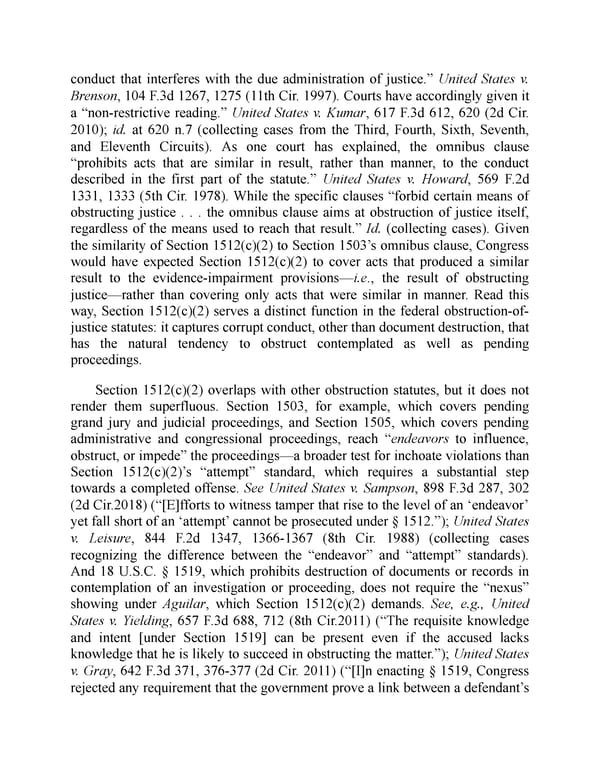conduct that interferes with the due administration of justice.” United States v. Brenson, 104 F.3d 1267, 1275 (11th Cir. 1997). Courts have accordingly given it a “non-restrictive reading.” United States v. Kumar, 617 F.3d 612, 620 (2d Cir. 2010); id. at 620 n.7 (collecting cases from the Third, Fourth, Sixth, Seventh, and Eleventh Circuits). As one court has explained, the omnibus clause “prohibits acts that are similar in result, rather than manner, to the conduct described in the first part of the statute.” United States v. Howard, 569 F.2d 1331, 1333 (5th Cir. 1978). While the specific clauses “forbid certain means of obstructing justice . . . the omnibus clause aims at obstruction of justice itself, regardless of the means used to reach that result.” Id. (collecting cases). Given the similarity of Section 1512(c)(2) to Section 1503’s omnibus clause, Congress would have expected Section 1512(c)(2) to cover acts that produced a similar result to the evidence-impairment provisions—i.e., the result of obstructing justice—rather than covering only acts that were similar in manner. Read this way, Section 1512(c)(2) serves a distinct function in the federal obstruction-of- justice statutes: it captures corrupt conduct, other than document destruction, that has the natural tendency to obstruct contemplated as well as pending proceedings. Section 1512(c)(2) overlaps with other obstruction statutes, but it does not render them superfluous. Section 1503, for example, which covers pending grand jury and judicial proceedings, and Section 1505, which covers pending administrative and congressional proceedings, reach “endeavors to influence, obstruct, or impede” the proceedings—a broader test for inchoate violations than Section 1512(c)(2)’s “attempt” standard, which requires a substantial step towards a completed offense. See United States v. Sampson, 898 F.3d 287, 302 (2d Cir.2018) (“[E]fforts to witness tamper that rise to the level of an ‘endeavor’ yet fall short of an ‘attempt’ cannot be prosecuted under § 1512.”); United States v. Leisure, 844 F.2d 1347, 1366-1367 (8th Cir. 1988) (collecting cases recognizing the difference between the “endeavor” and “attempt” standards). And 18 U.S.C. § 1519, which prohibits destruction of documents or records in contemplation of an investigation or proceeding, does not require the “nexus” showing under Aguilar, which Section 1512(c)(2) demands. See, e.g., United States v. Yielding, 657 F.3d 688, 712 (8th Cir.2011) (“The requisite knowledge and intent [under Section 1519] can be present even if the accused lacks knowledge that he is likely to succeed in obstructing the matter.”); United States v. Gray, 642 F.3d 371, 376-377 (2d Cir. 2011) (“[I]n enacting § 1519, Congress rejected any requirement that the government prove a link between a defendant’s
 Mueller Report PDF Page 491 Page 493
Mueller Report PDF Page 491 Page 493